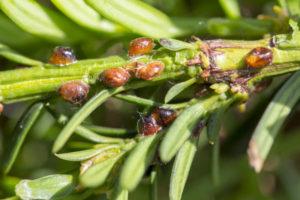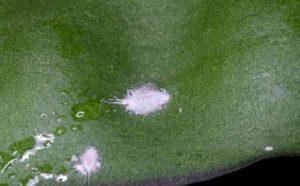Shchitovka: photo of an insect with a protective shell and the fight against it
One of the most common pests of indoor plants can be called scale insects. They belong to the Coleoptera family. There are over 2400 varieties. The appearance of these insects is fraught with the death of plants.
Content
Shchitovka: photo
Description of the pest
Name: Shchitovki family
Latin: diaspididaeClass: Insects - Insecta
Squad: Hemiptera - Hemiptera
 | Habitats: | fruit trees, indoor plants |
 | Dangerous for: | green parts |
 | Means of destruction: | pesticides, folk remedies |
| dimensions | The body is oval or round. Size from 1,5 to 2 mm. The largest variety reaches 5 mm. Under the scutellum, the body is white or pale brown without pronounced segmentation. In adults, the shield covers the entire body or parts. |
| Shields | The shield can be of different tones. For example, the central ring may be dark brown, while the outer ring may be golden brown. It can have a strongly convex, hemispherical, flattened shape. The color of the shield is yellowish-brown or dark brown. The shield includes the secretory part and larval skins. |
| Eggs | The eggs are oval in shape with a white or light gray tint. Later they become light brown. The size of the egg is from 0,1 to 0,3 mm. |
| Larvae | The first instar larvae are called vagrants. The body has a flattened oval shape. The length reaches 0,3 mm. The color of the larvae indicates the sex of the individual. White larvae are future females, red ones are males. Larvae of the second age are larger. The body is white or grey. Length 0,5 mm. The difference from adult scale insects is in size and lighter color. |
Life cycle
The pest has a pronounced life cycle. The female after fertilization consumes the juice of plants for 3 months. Then he lays eggs, the number of which ranges from 250 to 500. After laying, the scale insect dies.
The shape of the shield in females is elongated and rounded at the end. Under it are all fertilized eggs.
Hatching of vagrants begins at the end of May. The temperature should be at least 8 degrees Celsius. They settle on young weakly lignified branches or on shoots.
The female becomes sexually mature after 3 months. The mating season begins. There are much fewer males than females. The ratio can reach 1:5.
The duration of the development cycle is up to 1 year. Eggs mature within 9-10 months, larvae from 1 to 2 months. Southern latitudes suggest the formation of two generations during the year.
tropical scale insects
The tropical variety develops differently. The shield has a round shape.
Pests do not need an egg-laying house. The larvae overwinter in the bark and axils of the leaves.
In the spring, they leave the shelter and become females and males. 91% are females. After mating, the males die. Females are prone to virgin breeding.
The cycle time from vagrant to adult is 7 to 14 days. Some vagrants go into diapause in summer. This helps to overcome adverse conditions. Prolonged drought and heavy prolonged rains kill insects. Males have additional stages in the form of nymphs and pronymphs. The entire life cycle takes place within a month.
The scale insect is often confused with another similar insect - the false scale insect.
Damage from scale insects
Scale insects cause a lot of damage to plants. They quickly develop both in the open field and in the conditions of houses, greenhouses, apartments.
In the garden or vegetable garden
In the garden for 3 years they are able to destroy fruit trees.
The appearance of scale insects is characterized by sticky secretions on the foliage, a drop of sweetish sticky liquid. It can be seen on stems, petioles, leaves, buds, fruits. It contains dust and soot fungus.
In some warm countries, when a pest is detected, strict quarantine is mandatory. All plants are treated with pesticides. It is forbidden to export seedlings and seedlings.
Shields on indoor
They can get into the apartment with a flower or soil.
Their invasion can be seen by yellow spots. The spots increase, the leaves turn yellow or turn brown, curling and falling off.
The plant stops growing and dries out. The scale insect feeds not only on the leaves of plants, but on buds: tangerines, lemons, oranges, causing the ovaries to fall off and the flowers to dry out.
Due to the fact that indoor plants live in good conditions, many insects are very comfortable to settle on them. Get to know nearby pests of indoor plants can be found here.
Methods of struggle
The scale insect may not be immediately recognized if its location is under the leaves. It will spread quickly and spoil many plants. You need to start the fight immediately after a few shields are found. A few tips for pest control:
- isolate the affected plant from the rest, arranging quarantine for it;
- wipe the stems and leaves on each side with household, tar, green soap;
- use a hot shower, except for plants and soft leaves;
- in advanced cases, the use of Aktar, Confidor, Iskra, Fufafon, Mospilan, Colorado, Alatar, Aktellik, Novaktion at least 3 times with an interval of 7 days;
- wipe the place where the infected plant was located with alcohol or detergent.
Conclusion
Scale insects cause irreparable damage to plants. When the first signs of the appearance of pests are found, folk methods or insecticides are used. This will save the crop and indoor flowers.
Previous

